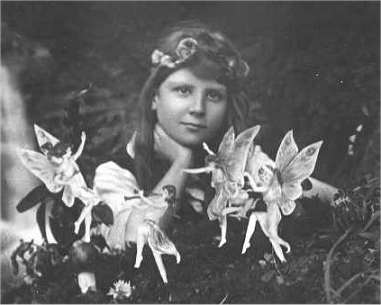By Iliana P-B
In 1917, Elsie Wright and Frances Griffiths took two photographs supposedly depicting fairies. They were friends living in Cottingley, England, who spent much time together playing outside. When they returned home one day, they blamed their dirty appearance on fairies they had played with. Elsie’s father, skeptic of their explanation, lent the girls his camera to take a photo of the fairies. When the photos were developed, they showed fairies dancing in a circle in front of Frances. Even after they gave him a second photo showing the girls with a gnome, he didn’t believe them. He was unusual in that respect.
Elsie’s mother was the one who propelled the photos into fame. Two years after they were taken, she presented them at a Theosophical Society meeting. The Theosophical Society is an organization interested in spirituality with the goal of uniting all of mankind regardless of sex, race, religion, or social status. After the photos were introduced, the society displayed them at their annual meeting. As they grew in popularity, they reached a photography expert named Harold Snelling. He determined that the photos were an unedited capture of what was in front of the girls at the time. He did not make a distinction on whether or not there were genuine fairies, just that there was no trace of studio editing work.
The prints circulated even more, eventually catching the attention of Sir Arthur Conan Doyle, the famous author and spiritualist. Doyle was already writing an article on fairies and got the rights to use the Cottinsley photos in his article. He saw those photos as proof that humans can communicate with the supernatural. Doyle’s involvement is one of the most striking pieces of this story. He was a doctor and the man who would create Sherlock Holmes, a detective renowned for his rational thought. Why then would he put his own reputation at risk over some photos? He believed the girls had photographed fairies. He even sent his friend to meet with the girls and ask them for more. The girls obliged, returning with three new photographs.
Part of why these photos became so popular was all the controversy and attention surrounding the effort to debunk them. As social scientists have argued in recent years, drawing attention to a myth while trying to fact check it can have a backfire effect. The myth becomes familiar and the point of the fact check is easily lost. The Cottingley Fairies are the perfect example of the backfire effect. As the photographs started to lose popularity, someone inevitably tracked Frances and Elsie down and asked for more photos or admissions of lying. In doing so, these investigators cemented the Cottingley Fairies in the public mind.
The Cottingley Fairies maintained their credibility and popularity for some time. Both Elsie and Frances maintained that the photos were real until 1983. It was then, in a letter, that Elsie admitted they had drawn wings on cutouts from a book and stuck them in the ground using pins and string. But Frances maintained she had always seen fairies. When Elsie said it was a fraud, their relationship became worn. It wasn’t until 1982 that a scientific study conducted by Geoffrey Crawley proved that the fairies were fake. While photographic deception may be commonplace in the twenty-first century, throughout most of the twentieth century most people saw photography as a scientific tool. The ease with which one could doctor a photo was not well understood. There was little reason to doubt the young girls’ claims, especially if you wanted it to be true.
In 1917, people had good reason to want fairies to be real. World War I was in full swing. Germany was attempting to cut off British ships which led to starvation and loss of hundreds of thousands of tons of cargo. A famine across Europe cost over 8 million Europeans their lives. Chemical agents inflicted a heavy emotional toll during the war. Mustard gas stayed on the ground for days to weeks and continued to cause harm. When someone got it on their clothes, they spread it to the other soldiers trying to help them. Who wouldn’t want to believe in something magical and supernatural when they are faced with horrors like this? In fact, according to Patrick Houlihan, a great number of suspected supernatural occurrences cropped up during the war. Soldiers had fallen comrades move them out of the way of incoming shells or fight back German advances. If ghosts were real, why not fairies too? While these fairies weren’t real, they provided something that the people of Europe really needed: a source of joy. .
Children think about fairies Countless children’s books tell tales of fairies and always have a happy ending. An attachment, even slim, to one’s happy childhood can help people get through tough times. We often imagine modern societies to be secular and rational, but the Cottingley fairies’ popularity suggests that when the real world seems to be falling apart, many people are willing to believe in an enchanted world.
